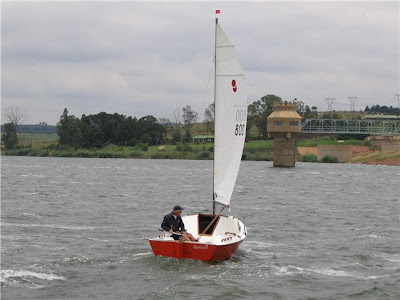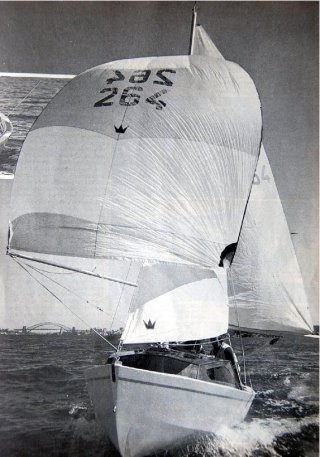Cherry 16 Specifications
LOA 4.75m, Beam 2.15m, Trailer Weight 220Kg
Sail Area
Main 7.6 sq meter, Jib 3.8 sq meter, Spinnaker 7.8 sq meter
The Cherry is a light weight trailer yacht designed to be built with a minimum of experience. The bottom and side panels are scarfed together to form full length panels. These are then laced together with 80lbs monofilament line or copper wire and all the joins glass taped with two layers of fibreglass tape and epoxy resin bonded. The hull itself takes 3 to 4 days to build and the complete craft approximately 3 weeks.
The layout consists of a vee bunk forward plus two quarter berths under the cockpit seats. The bunks form an intergral part of the structure of the craft. The Cherry has a fairly fine entry and flattens out to a wide planing section aft, and the large cockpit, nearly 2.4 m long allows the weight of the crew to be kept amidships when sailing. Because of the light weight, the rig has been kept relatively small but the sail area to weight is comparable with most other craft of this type. The pivoting centreboard is housed under the cockpit floor and is controlled by a wire strop coming up over the pully and is raised and lowered with a simple block and tackle. Because of the light weight the Cherry is easily trailered and requires only an extended box trailer or a simple trailer with two cradles.
All plywood panels are 6mm thick, except the centreboard case and cockpit floor which is 9mm. The Cherry will take a 6 HP outboard motor mounted on the transom bracket.
















2 comments:
hallo
Will send some more photos after I have made them somewhat smaller.
Spica sailing in windy and gusty conditions with jib furled at the Pretoria sailing Club in Pretoria, South Africa.
I have had to modify the cabin roof somewhat so that I could move the mast aft and I also moved the front stay aft on the foredeck. I was experiencing far to much lee helm and the problem is now fixed,
I built the boat according to plan and placed the mast as suggested by Barry Armstrong from Brisbane but there is something not write with the mast postion or mayube I made a mistake somewhere - I would not know where. More people I communicated with had this problem. Some solved the problem by extreme raking of the mast backwards but I decided to modify the cabin roof etc. The boat is very sensitive for weight distribution and I can now often steer the boat without touching the tiller and just move my weight about .
You will also see that the stays are high up on the mast. The mast is an old Sharpie mast that I modified .and i have since then attached some diamond stays to prevent mast bend of the middle section. Maybe I will relocate the spreaders lower down sometime But I am happy with my toy and am trailing to sailing regattas such as the SANLAM Round the Island Yacht Race every end of Jaqnuary. and other sailing venues. Look it up on the net.
Nice to talk with you from the sert town I now live in for a couple of years. But June-July I will be in South Africa and do a lot of winter sailing in the nice climate we have then during the day.
Cheers,
Wilfried
Al Ain
UAE
Basically the Cherry sail plan had design faults. The result was the Cherry Association class rules incorporated a larger roach to correct the lee helm problem, and made the J measurements variable between 1.85m and 2.00m. The best position for the spreaders is .45 of the height to the hounds. Another problem was the spinnaker design which lacked shoulders, this again was modified as shown in the YNSW specifications to leach of 4.730m and max width of 3.870m. A registered modification {Shivers}was to increase the mast height and boom length to give a significantly large main. A cheap alternative was to use a second hand Hartley 16 mast and mainsail. Both of these made the Cherry handle better. These latter specifications were lodged with the YSA and appears on their TY CBH list.
Post a Comment